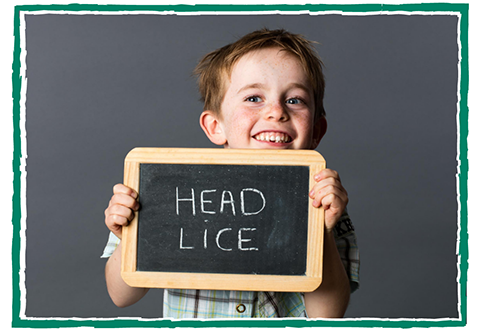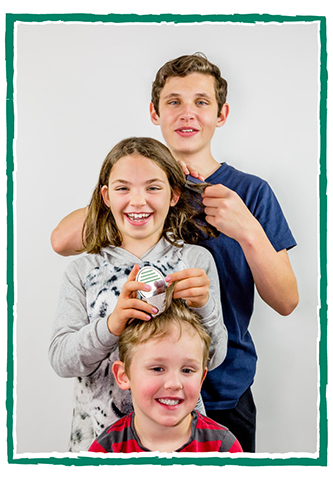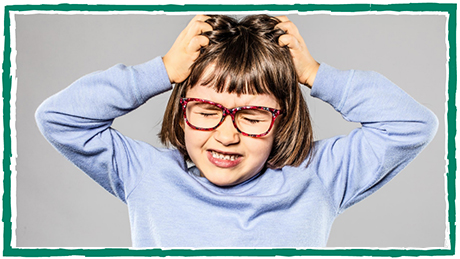Head Lice Helpful Information
Head Lice can be a real problem. Back to school will be uncharted territory this year for so many different reasons. However, one of the few things we can guarantee is that we will usually get a small outbreak of head lice as children returning to school. Since protocol for return varies from province to province there still is the opportunity for a head lice outbreak.
Check out: Health Link BC / head lice
 Head Lice Identification
Head Lice Identification
Head lice are tiny, greyish brown, wingless insects that live on the scalp, feeding on human blood. They lay eggs that stick to strands of hair very close to the scalp. Once the egg hatches, the empty case left behind is called a nit.
Head lice are hard to see because they are tiny and move around on the head. Eggs are very small, about one-third (1/3) the size of a sesame seed and take 9 to 10 days to hatch.
The nits are easier to see and are found further down the hair shaft. Both eggs and nits may look like dandruff, but they cannot be easily removed because they are sticky.
[expand title=”Read More!”]
Do head lice cause illness or spread disease?
No, head lice do not cause illness or spread disease. However, they can be irritating, because they cause discomfort and spread easily from person to person.
How are head lice spread?
Anyone can get head lice. Having head lice does not mean a person has poor personal hygiene or lives in an unclean environment. Anyone who has hair can get head lice.
Head lice are commonly spread among children and adults who have close head-to-head contact. Head lice cannot jump or fly from 1 person to another. They are most commonly spread through head-to-head contact by crawling from one hair to another. There is a very small chance of head lice spreading indirectly though shared pillowcases, hair accessories, brushes and combs.
How do I prevent the spread of head lice?
The best way to control head lice is through the cooperation of parents, children, daycares, schools and health care providers. Checking the hair of all family members regularly using the wet combing method is the best way to prevent the spread. Encourage children not to share hats, combs, hair accessories or hairbrushes. If your child has long hair, tie it up or put it in a braid.
Having head lice once does not prevent someone from getting them again. Regular checks for head lice can be part of a family’s hygiene routine.
What are the symptoms of head lice?
Often people who have head lice will have no symptoms for 4 to 6 weeks with their first case.
Symptoms of head lice may include:
• Crawling or tickling sensation on the scalp
• Itchy scalp due to a sensitive reaction caused by the bites
• Scratch marks or small red bumps like a rash
How can I tell if my child has head lice?
The most accurate way to check for head lice is the wet combing method:
• Wash and rinse the hair. Apply enough conditioner to cover the whole scalp (usually 2 handfuls). The conditioner stops the lice from moving, making them easy to find
• Use a wide tooth comb to get the tangles out. At any time if the comb tugs, add more conditioner
• Begin combing the entire head with a lice comb. Pull the comb through the hair in one stroke from the front to the back of the head. Keep the teeth in contact with the scalp for the entire stroke
• After each stroke, wipe the comb on a paper towel and check for lice
 What are safe options for treating head lice?
What are safe options for treating head lice?
There are many different products and ways to treat head lice. Some health experts recommend wet combing and others recommend chemical treatments. Only consider treatment if you find live lice. Head lice will not go away without treatment.
Children should receive their first treatment, whether wet combing or chemical, at home the first day that they are found to have head lice. Children should not be sent home or kept home from school or daycare because of head lice. Encourage the child to avoid head-to-head contact with other students until after their first wet combing or chemical treatment.
If one person in the household has head lice, there is a good chance other household members do as well. All members of the household should be checked on the same day and those with lice should be treated.
Wet Combing treatment
This method removes live head lice. Wet combing is less expensive and non-chemical. Combing treatments follow the same steps used to check for lice. Use generous amounts of hair conditioner and a special lice comb, every 4 days for at least 2 weeks. If you find lice on the final combing, add one more combing in 4 days until you find no live lice. Any young lice that hatch from eggs after the first session are removed at the second, third and fourth sessions. This is why it is important to do the full series of sessions.
Wet combing is safe for infants, young children, as well as pregnant and nursing mothers. Contact your public health unit for complete instructions on the wet combing method. To find your local public health unit, visit: Regional Health Authorities.
Chemical treatments
Shampoos, creams, rinses and sprays that contain an ingredient that kills lice are available at most pharmacies without a prescription. Some examples are permethrin, pyrethrins, isopropyl myristate and dimethicone.
Some chemical treatments may not be safe for infants, young children, pregnant or nursing mothers or other individuals. Speak to your health care provider or pharmacist to find out which is best for you or your child. Always carefully follow the directions for use on the label and be sure to keep the products out of the reach of young children.
After treatment, check the hair and remove eggs and lice. You can also remove the nits, although you don’t have to remove them, as nits are empty eggshells.
Most treatments are repeated in 7 to 10 days to make sure that any head lice that have hatched after the first treatment are killed before they have a chance to lay any eggs. It is also important to check the head for any eggs and remove them after the second treatment. Itching may last for 7 to 10 days, even after successful treatment.
Head lice have started to develop resistance to many of the chemical products. If you think the product is not working after 24 to 48 hours, use the wet combing method to check for lice. If you find lice, use a different treatment method. Head lice cannot develop resistance to non-chemical treatments.
When should I call my health care provider?
Call your health care provider if the treatments are not successful or if you are unsure which kind of treatment is best for you or your child. Chemical treatment of pregnant or nursing mothers and of children less than 4 years of age should be given only under the direction of a health care provider.
What options are not recommended for treating head lice?
Some methods and products should not be used because they are either not safe or do not work. These products include: insect sprays, motor oil, gasoline, alcohol, flea soap, dyes, bleaches, heat applied to the scalp, garlic, tea tree and other essential oils, electric lice combs, and shaving the head.
What should be cleaned?
Healthy head lice rarely leave the scalp and if they do they may only survive for 24 to 55 hours. Head lice are not shared through contact with furniture, pets or carpets. There is no evidence that a major cleaning of the house or car is necessary. Hats, pillowcases, combs and hairbrushes that have had contact with the head of the person with head lice in the previous 48 hours, could be considered for cleaning in hot soapy water. Items that can’t be washed can be placed in a plastic bag for 2 weeks or in the freezer for 48 hours. Clean supplies that you used for wet combing in hot soapy water.[/expand]
If you would like more information, just give us a call!
Our friendly Pharmacists are also available for a Facetime Chat!
(no need to download any programs)
We’ll send you a link with only 1 click!
Let us know how we can help you and your family.
Find out more about Howe Sound Pharmacy:
Products & Services – Patient Forms – Find Us – Contact Us
Howe Sound Pharmacy Ltd. has been serving the Sunshine Coast for over 40 years!
Call us for any concerns you have with your health or drug information!
Chris Juozaitis – Pharmacist
Caring Beyond Medications
Howe Sound Pharmacy Ltd.
(604) 886-3365 or 1(888) 886-3365
208 – 1100 Sunshine Coast Hwy, Gibsons
– in the Gibsons Park Plaza near the Gibsons Medical Clinic –
Sunshine Coast, BC

